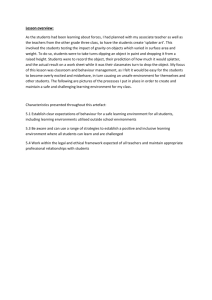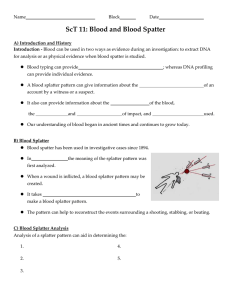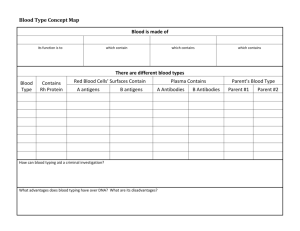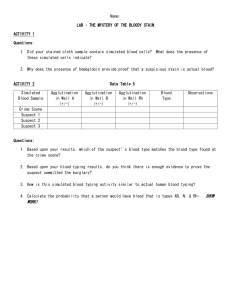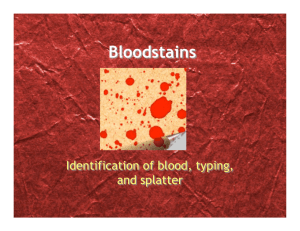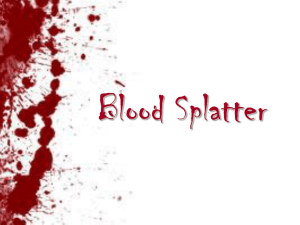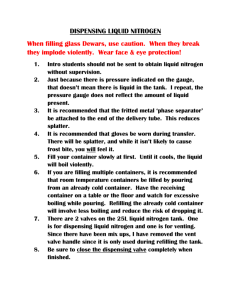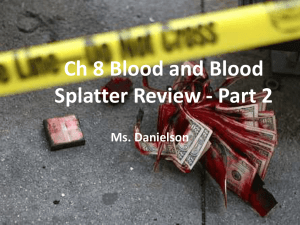Chapter 8 Blood and Blood Splatter
advertisement
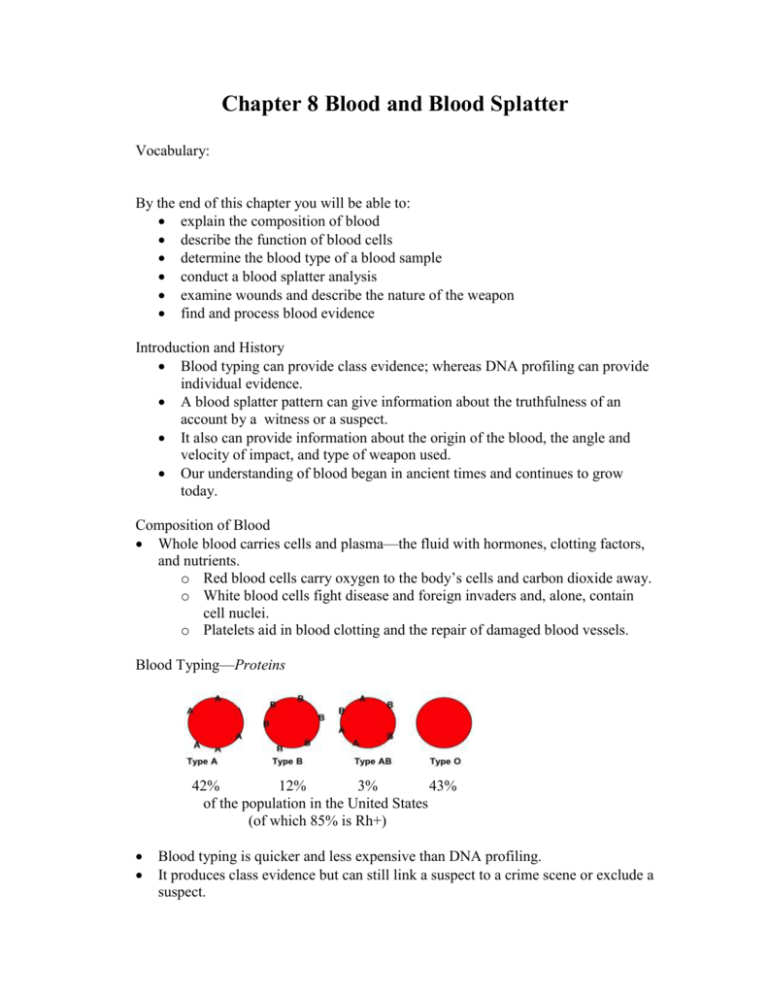
Chapter 8 Blood and Blood Splatter Vocabulary: By the end of this chapter you will be able to: explain the composition of blood describe the function of blood cells determine the blood type of a blood sample conduct a blood splatter analysis examine wounds and describe the nature of the weapon find and process blood evidence Introduction and History Blood typing can provide class evidence; whereas DNA profiling can provide individual evidence. A blood splatter pattern can give information about the truthfulness of an account by a witness or a suspect. It also can provide information about the origin of the blood, the angle and velocity of impact, and type of weapon used. Our understanding of blood began in ancient times and continues to grow today. Composition of Blood Whole blood carries cells and plasma—the fluid with hormones, clotting factors, and nutrients. o Red blood cells carry oxygen to the body’s cells and carbon dioxide away. o White blood cells fight disease and foreign invaders and, alone, contain cell nuclei. o Platelets aid in blood clotting and the repair of damaged blood vessels. Blood Typing—Proteins 42% 12% 3% 43% of the population in the United States (of which 85% is Rh+) Blood typing is quicker and less expensive than DNA profiling. It produces class evidence but can still link a suspect to a crime scene or exclude a suspect. Blood Typing—Antibodies; Additional Proteins and Enzymes Antibodies are proteins secreted by white blood cells that attach to antigens to destroy them. Antigens are foreign molecules or cells that react to antibodies. Enzymes are complex proteins that catalyze different biochemical reactions. Many enzymes and proteins have been found in the blood that are important for identification purposes. Blood Typing—Probability and Blood Types Given the frequency of different genes within a population, it is possible to determine the probability that a particular blood type will appear in a particular population. To determine the probability of two separate events, it is necessary to multiply their individual probabilities. By identifying the additional proteins in the blood evidence sample, investigators can limit the size of a suspect population and help identify a suspect. Blood Splatter In 1939 the meaning of the splatter pattern was first analyzed. When a wound is inflicted, a blood splatter pattern may be created. It takes a grouping of blood stains to make a blood splatter pattern. The pattern can help to reconstruct the events surrounding a shooting, stabbing, or beating. Laws of Physics All fluids follow the laws of physics What Forces affect falling objects? Newton’s Laws of Motion??? Falling o Gravity o Air Resistance o Surface Tension, in the case of any fluid containing a high % of H2O Newton’s 1st Law of Motoin Resists changing motion until a force is applied o blood tries to remain moving at the speed of the source o As gravity pulls it down, it is shaped by air and surface tension Newton’s 2nd Law Force applied is proportional to Acceleration achieved F = mass x acceleration Work done = F x distance fallen o Greater fall results in greater spattering o Wider spatter from greater fall Greater work weakens surface tension o Greater work done Flatter stain from reducing surface tension Newton’s 3rd Law Action and Reaction Force of impact causes floor to apply reaction force on blood Blood Splatter Analysis Analysis of a splatter pattern can aid in determining the: o direction blood traveled o angle of impact o point of origin of the blood o velocity of the blood o manner of death Blood Splatter Analysis When blood falls from a height or at a high velocity, it can overcome its natural cohesiveness and form satellite droplets. When it falls onto a less-than-smooth surface, it can form spiking patterns around the drops. Blood Splatter Analysis—Six Patterns passive drops arterial gushes splashes smears trails pools Impact Patterns can help investigators determine the type of weapon used. Calculate with two measurements Length of satin and width of stain Impact Angle θ = sin -1 (width/length) L W Speed/Velocity Stain is more elongated with faster movement Directionality The shape of an individual drop of blood provides clues to the direction from where the blood originated. Tail shows direction How will the point of impact compare with the rest of a blood pattern? Location of the Origin of the Blood Lines of convergence a. Draw straight lines down the axis of the blood splatters. b. Where the lines converge, the blood originated. Crime Scene Investigation of Blood 1. Search for blood evidence. 2. If any is discovered, process it determining: a. Whether the evidence is blood. b. Whether the blood is human. c. The blood type. 3. Interpret the findings: a. See if the blood type matches a suspect. b. If it does not, exclude that suspect. c. If it does, decide if DNA profiling is needed.
